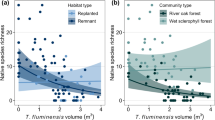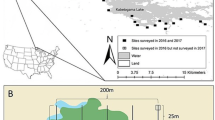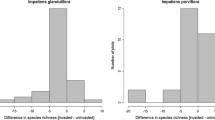Abstract
Native species can coexist with invasive congeners by partitioning niche space; however, impacts from invasive species often occur alongside other disturbances. Native species’ responses to the interactions of multiple disturbances remain poorly understood. Here we study the impacts of urbanization and an invasive congener on a native species. Using abundance (catch-per-unit effort) and vertical distribution of native green anoles (Anolis carolinensis) and invasive brown anoles (Anolis sagrei) across a gradient of natural-to-urban forests, we ask if niche shifting (lability) is occurring, and if it can mitigate impacts from one or both disturbances. We use generalized linear models to relate species abundances across the landscape to urbanization, forest structural complexity, and congener abundances (i.e., A. sagrei); and test for an interaction between urbanization and congener abundance. Our data show that A. sagrei presence results in a 17-fold upward shift in vertical niche of A. carolinensis—an 8.3 m shift in median perch height, and models reveal urbanization also drives an increase in A. carolinensis perch height. A. carolinensis and A. sagrei abundances negatively and positively correlate with urbanization, respectively, and neither species’ abundance correlate with congener abundance. Despite a positive correlation between A. sagrei abundance and urbanization, our results do not show evidence of this interaction affecting A. carolinensis. Instead, niche lability appears to enable the native species to mitigate the impact of one driver of decline (invasive competition) while our data suggest it declines with the second (urbanization).


Similar content being viewed by others
Data availability
The data from this study will be archived in an online repository (Dryad) upon acceptance and publication, and R-script provided upon request.
References
Akinwande MO, Dikko HG, Samson A (2015) Variance inflation factor: As a condition for the inclusion of suppressor variable(s) in regression analysis. Open J Stat 05:754–767. https://doi.org/10.4236/ojs.2015.57075
Basham EW, Scheffers BR (2020) Vertical stratification collapses under seasonal shifts in climate. J Biogeogr. https://doi.org/10.1111/jbi.13857
Brook BW, Sodhi NS, Bradshaw CJA (2008) Synergies among extinction drivers under global change. Trends Ecol Evol 23:453–460. https://doi.org/10.1016/j.tree.2008.03.011
Burnham K, Anderson D (2004) Model selection and multi-model inference, 2nd edn. Springer, NY
Campbell TS (2000) Analyses of the effects of an exotic lizard (Anolis sagrei) on a native lizard (Anolis carolinensis) in Florida, using islands as experimental units. PhD dissertation. University of Tennessee
Culbertson KA, Herrmann NC (2019) Asymmetric interference competition and niche partitioning between native and invasive Anolis lizards. Oecologia 190:811–820. https://doi.org/10.1007/s00442-019-04466-1
Didham RK, Tylianakis JM, Gemmell NJ et al (2007) Interactive effects of habitat modification and species invasion on native species decline. Trends Ecol Evol 22:489–496. https://doi.org/10.1016/j.tree.2007.07.001
Doherty TS, Dickman CR, Nimmo DG, Ritchie EG (2015) Perspective Multiple threats, or multiplying the threats? Interactions between invasive predators and other ecological disturbances. Biol Conserv 190:60–68. https://doi.org/10.1016/j.biocon.2015.05.013
Gaertner M, WilsonCadotte UJRMW et al (2017) Non-native species in urban environments: patterns, processes, impacts and challenges. Biol Invasions 19:3461–3469. https://doi.org/10.1007/s10530-017-1598-7
Harrington LA, Harrington AL, Yamaguchi N et al (2015) The impact of native competitors on an alien invasive: temporal niche shifts to avoid interspecific aggression? Ecology 90:1207–1216
Jenssen TA, Greenberg N, Hovde KA (1995) Behavioral profile of free-ranging male lizards, Anolis carolinensis, across breeding and post-breeding seasons. Source Herpetol Monogr 9:41–62
Jepson J (2000) The tree climber’s companion: a reference and training manual for professional tree climbers. Beaver Tree Pub, Longville
Kamath A, Stuart YE, Campbell TS (2013) Behavioral partitioning by the native lizard Anolis carolinensis in the presence and absence of the invasive Anolis sagrei in Florida. Breviora 535:1–10. https://doi.org/10.3099/MCZ8.1
Kelch N-S, Neves FS, Fernandes GW, Wirth R (2016) Mechanisms driving galling success in a fragmented landscape: synergy of habitat and top-down factors along temperate forest edges. PLoS ONE 11:e0157448. https://doi.org/10.1371/journal.pone.0157448
Kraus F (2015) Impacts from invasive reptiles and amphibians. Annu Rev Ecol Evol Syst 46:75–97. https://doi.org/10.1146/annurev-ecolsys-112414-054450
Losos JB (2009) Lizards in an evolutionary tree: ecology and adaptive radiation of anoles. University of California Press, Berkeley
Losos JB, Spiller D (1999) Differential colonization success and asymmetrical interactions between two lizard species. Ecology 80:252–258
Mooney HA, Cleland EE (2001) The evolutionary impact of invasive species. Proc Natl Acad Sci 98:5446–5451
Padayachee AL, Irlich UM, Faulkner KT et al (2017) How do invasive species travel to and through urban environments? Biol Invasions 19:3557–3570. https://doi.org/10.1007/s10530-017-1596-9
Pianka ER (1974) Niche overlap and diffuse competition. Proc Natl Acad Sci 71:2141–2145
Rand TA, Louda SM (2006) Spillover of agriculturally subsidized predators as a potential threat to native insect herbivores in fragmented landscapes. Conserv Biol 20:1720–1729. https://doi.org/10.1111/j.1523-1739.2006.00507.x
R Core Team (2017) R: a language and environment for statistical computing. https://www.R-project.org/
Reichert BE, Sovie AR, Udell BJ et al (2017) Urbanization may limit impacts of an invasive predator on native mammal diversity. Divers Distrib 23:355–367. https://doi.org/10.1111/ddi.12531
Scheele BC, Foster CN, Banks SC, Lindenmayer DB (2017) Niche contractions in declining species: mechanisms and consequences. Trends Ecol Evol 32:346–355. https://doi.org/10.1016/j.tree.2017.02.013
Scheffers BR, Williams SE (2018) Mountain passes are high in the tropics—but not for arboreal species. Front Ecol Environ 16:101–108. https://doi.org/10.1002/fee.1764
Scheffers BR, Phillips BL, Laurance WF et al (2013) Increasing arboreality with altitude: a novel biogeographic dimension. Proc R Soc B Biol Sci. https://doi.org/10.1098/rspb.2013.1581
Scheffers BR, Shoo L, Phillips B et al (2017) Vertical (arboreality) and horizontal (dispersal) movement increase the resilience of vertebrates to climatic instability. Glob Ecol Biogeogr 26:787–798. https://doi.org/10.1111/geb.12585
Schoener TW, Schoener A (1982) Intraspecific variation in home-range size in some Anolis lizards author (s): Thomas W. Schoener and Amy Schoener published by : ecological society of america intraspecific variation in home-range size in some anolis lizardS ’. Ecology 63:809–823
Stuart YE, Campbell TS, Hohenlohe PA et al (2014) Rapid evolution of a native species following invasion by a congener. Science 346:463–466
Symonds MRE, Moussalli A (2011) A brief guide to model selection, multimodel inference and model averaging in behavioural ecology using Akaike’s information criterion. Behav Ecol Sociobiol 65:13–21. https://doi.org/10.1007/s00265-010-1037-6
Szulkin M, Garroway C, MC-U evolutionary, 2020 U et al (2020) How to quantify urbanisation when testing for urban evolution? Urban evolutionary biology. Oxford University Press, Oxford
Thawley CJ, Moniz HA, Merritt AJ et al (2019) Urbanization affects body size and parasitism but not thermal preferences in Anolis lizards. J Urban Ecol. https://doi.org/10.1093/jue/juy031
Toft CA (1985) Resource partitioning in amphibians and reptiles. Source Copeia 1985:1–21
Vilà M, Espinar JL, Hejda M et al (2011) Ecological impacts of invasive alien plants: a meta-analysis of their effects on species, communities and ecosystems. Ecol Lett 14:702–708. https://doi.org/10.1111/j.1461-0248.2011.01628.x
Weber WD, Anthony NM, Lailvaux SP (2021) Size but not relatedness drives the spatial distribution of males within an urban population of Anolis carolinensis lizards. Ecol Evol 11:2886–2898. https://doi.org/10.1002/ece3.7248
Wilson Rankin EE, Knowltonid JL, Gruner DS et al (2018) Vertical foraging shifts in Hawaiian forest birds in response to invasive rat removal. PLoS ONE. https://doi.org/10.1371/journal.pone.0202869
Winchell KM, Reynolds RG, Prado-Irwin SR et al (2016) Phenotypic shifts in urban areas in the tropical lizard Anolis cristatellus. Evolution (n Y) 70:1009–1022. https://doi.org/10.1111/evo.12925
Winchell KM, Carlen EJ, Puente-Rolón AR, Revell LJ (2018) Divergent habitat use of two urban lizard species. Ecol Evol 8:25–35. https://doi.org/10.1002/ece3.3600
Winck GR, Almeida-Santos M, Dorigo TA et al (2017) When invasion may not be harmful: niche relations in a lizard assemblage. Biotropica 49:117–129. https://doi.org/10.1111/btp.12348
Zuur AF, Ieno EN, Walker NJ et al (2009) Mixed effects models and extensions in ecology with R. Springer Science & Business Media, Berlin
Acknowledgements
We thank Christian Garcia, Shannon Finnerty, Emily Steffes, and our many other research assistants. We declare no conflicts of interest. All applicable institutional and/or national guidelines for the care and use of animals were followed.
Funding
Not applicable.
Author information
Authors and Affiliations
Contributions
JBB and BRS designed the research; BRS funded the research; JBB, SB and BRS wrote the paper; JBB collected and analyzed the data.
Corresponding author
Ethics declarations
Conflict of interest
The authors declare no conflicts of interest or competing interests.
Ethics approval
All research was approved by the University of Florida’s IACUC committee.
Consent to participate
Not applicable.
Consent for publication
Not applicable.
Additional information
Communicated by Lin Schwarzkopf.
Our study examines the impacts of two current major threats to global biodiversity—invasive species and urbanization—and explores how vertical niche lability could mitigate such threats.
Supplementary Information
Below is the link to the electronic supplementary material.
Rights and permissions
About this article
Cite this article
Borden, J.B., Bohlman, S. & Scheffers, B.R. Niche lability mitigates the impact of invasion but not urbanization. Oecologia 198, 1–10 (2022). https://doi.org/10.1007/s00442-021-05039-x
Received:
Accepted:
Published:
Issue Date:
DOI: https://doi.org/10.1007/s00442-021-05039-x




